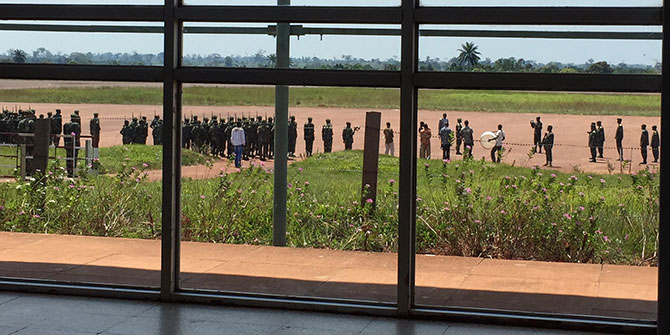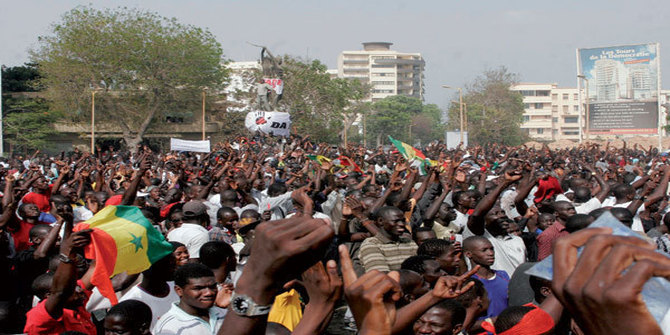Koen Vlassenroot, Emery Mudinga and Josaphat Musamba Bussy tackle the complexities around the remobilisation of armed combatants following conflict and introduce new ways to look at it.
This article is part of our #LSEReturn series, exploring themes around Displacement and Return.
In this article, we introduce the notion of circular return to explain the permanent state of mobility between civilian and combatant life of combatants. The phenomenon is widely seen in eastern DRC, where thousands of Congolese youth have been going in and out of armed groups for several decades now. While the notion of circular return has its origins in migration and refugee studies, we argue that it also serves as a useful lens to describe and understand processes of incessant armed mobilisation. In conceptualising these processes as forms of circular return, we want to move beyond the remobilisation discourse, dominant both in DDR literature and policy speech. This discourse tends to be too security oriented, emphasising the security threat of armed mobilisation and the failure of DDR processes and the institutions supporting them. More importantly, it ignores combatants’ agency and larger processes of socialisation and social rupture, which are key drivers of armed (continued) mobilisation. We argue that armed groups are experiments in creating new social spaces, providing new forms of social capital and constituting new identities. Circular return points at combatants’ capacity to navigate between these new spaces and older ones.
Circular displacement
Recently introduced concepts such as ‘circular migration’, ‘circular mobilities’, ‘split return’ or ‘recycled refugees’, all recognise the mobility of migrant or refugee populations and point at the repeated migration experiences between an origin and destination involving several migrations and returns. While circular migration as part of human mobility is not a new phenomenon, it only recently received wider recognition both in literature and policy statements. Little agreement exists on its definition. Schneider and Parusel f.i. understand circular migration as “a flexible form of repetitive movement between different destinations.” Other definitions point at the developmental impact or at its voluntariness and legal aspects. For the Global Forum on Migration and Development, circular migration refers to “the fluid movement of people between countries, including temporary or long-term movement which may be beneficial to all involved, if occurring voluntarily and linked to the labour needs of countries of origin and destination.”
Displacement literature equally recognises the existence in certain cases of a permanent condition of mobility of Internally Displaced People (IDP) and refugees, recently also described as ‘pendular mobility’ or ‘circular return’. In conflict environments, pendular mobility of IDPs points at mobility as a way of life, or as a permanent condition and strategy to seek for security and protection, including the daily return to what are considered safer areas to spend the night. At the same time, circular return refers to a rather a-typical dynamic linked to displacement, which is the return of refugees to their host-communities mainly as a consequence of failed return and reintegration at ‘home’.
The cycle of mobilisation – demobilisation – remobilisation
Similar patterns of pendular mobility can be identified among members of armed groups. A constant cycle of mobilisation – demobilisation – remobilisation as observed in eastern Congo, both points at the persistence of drivers of mobilisation and the failures of demobilisation efforts. This cycle has been documented at large, and several reasons behind its persistence have been discerned. Reasons for its existence include the perseverance of unresolved conflict dynamics; the proliferation of a rising number of small armed groups, contributing to a fragmentation of the military landscape; the growing involvement of low-level political actors in armed mobilisation leading to a democratisation of militarised politics; failures of demobilisation and reintegration efforts; and disruptive military responses. What received far less attention in existing analysis is the position of ex-combatants themselves, and their incentives to regularly rejoin armed groups.

A rich literature on ex-combatants and their mobility in post-conflict settings has documented cases including El Salvador, Sierra Leone, Mozambique, Liberia, Colombia, Burundi and the DR Congo. Most analyses label the pendular mobility of combatants, or the continuous mobility between combatant and civilian spaces, in terms of remobilisation. It is argued that combatants, despite organised or voluntary demobilisation and reintegration, often risk returning to the bush and rejoin their former comrades or risk moving to alternative armed groups. In other cases, combatants respond to calls from politicians or other Big Men who strategically rely on (networks of) ex-combatants and other marginalised youth for their own (political) campaigns or in defense of private interests, a phenomenon described by Christinsen and Utas as ‘politricks’. And in still other cases, ex-combatants are considered responsible for persistent levels of insecurity because of their assumed involvement in organised crime and crime networks after the war has ended.
All of these scenarios incite the need for DDR programmes, which are considered a crucial part of peace building strategies. For Wiegink, who studied the case of Renamo in Mozambique, these programmes start from two misleading assumptions. One is that “ex-combatants would naturally want to return ‘home’,” without taking into consideration what home is and how it changed during the war. The second assumption is that armed groups are considered mainly as military structures that can easily be dismantled, ignoring the fact that they also entail a web of social relationships. As the case of Sierra Leone reveals, war-time mobilisation networks tend to continue after the termination of conflict. The same can be said about the networks of solidarity and support between ex-combatants. As Wiegink observes in the case of Renamo, ex-combatants do not simply fade away, but continue to be an important identity in post-war politics and society.
These realities help to explain why armed structures remain an option to those who have left them even after the formal end of war. While the return to armed struggle is a “profoundly multi-layered and social process,” so is the individual decision to take part in it. The narrative of remobilisation, however, obscures the complexities explaining it. It is mainly understood in terms of a return to violence and combat, itself the result of “an interaction between entrepreneurs of violence, military affinities, intermediaries, and selective incentives.” More importantly, it pays little attention to the agency of those being mobilised, the larger social processes and context leading to a return to armed combat, the effects of long-term membership of armed groups and the socialisation process this membership entails. Therefore, we argue that there is a need move away from framing combatant mobility in terms of remobilisation and understand it as a process of circular return, which describes more precisely the constant in-and-out of combatants.
Circular return in eastern Congo
Also in the case of eastern DR Congo, where several generations of local youth have joined rurally-based armed groups, rebel movements or local defense forces, both during and after the Congo wars, attempts to disarm and demobilise them have had limited effect and armed structures have also shown strong resilience to DDR efforts. Ex-combatants often decide to return to these armed groups or respond to opportunities provided by newly created ones. In Shabunda (South Kivu), Kalehe (South Kivu) or Masisi (North Kivu) and other areas of research, we observed how local youth constantly navigate between their position and role of combatant and civilian. Being part of two different social environments has become a permanent condition of life and is guided by a complex interplay between social and political dynamics, collective needs and grievances, and individual interests. Yet, at the same time the mobility between these different spaces suggest that boundaries between civilian and combatant spheres are less strict than generally assumed. Not everyone prefers to stay in this state of pendular mobility. Those who received considerable advantages (such as a motor-bike) as part of reinsertion programmes, usually do not return to the armed group to which they belonged. Others, however, have limited access to alternative opportunities and find it more difficult to cut the links with their former comrades and commanders. This could be because of strong pressures of rebel commanders, leading to ‘forced circular return’ as we observed in Shabunda with the Raya Mutomboki or in Masisi with APCLS members. It could be a result of shifts in the security context and the consequent need to protect the community, revealing a permanent state of readiness of ex-commanders. It could be out of frustration with the limited benefits and results of reintegration into society and the difficulties to return to civilian life. It could be out of nostalgia with the material and social advantages of combatant life, explained by one combatant as “kukula kwa bure”, or the habit to “eat without too many efforts required”. It could be because of the attractiveness of the dawa medicine, which is mobilised as a combat tactic yet also providing spiritual guidance and protection to combatants. And finally, while demobilisation programmes provide exit-strategies that could be considered opportunities to resist against armed groups and their command structures, a return to the same groups could be a form of resistance against reintegration efforts and against new social codes of conduct, norms and values ex-combatants are confronted with and are considered as not corresponding with their own values and norms.
Processes of socialisation
In short, the circular return of combatants is inspired by a multitude of incentives, ideologies, factors and processes, which go beyond dominant arguments about failed reintegration processes or ‘Big Men’ mobilisation efforts in search of an increase of their bargaining power. If we want to unravel the complexities of circular return and to develop adequate responses, we need to integrate ex-combatants agency and the long-term effects of prior mobilisation into our frameworks of analysis. Their readiness to return to combat indeed is largely influenced by past and present experiences, including social and political challenges faced with after leaving armed groups. These experiences not only explain the appeal of return but also the different difficulties ex-combatants face when trying to re-integrate into their communities but also the blurred boundaries between different social spaces. Long-term armed mobilisation should be considered a process of socialisation. The presence of armed groups should be seen as a moment of social rupture as much as an experiment in constituting a new social space, a new way of life, a new form of social capital, and eventually a new identity. Ex-combatants’ consequent capacity to navigate between different spaces largely defines their response to new political or security dynamics, to mobilisation and demobilisation campaigns, or to their own individual challenges and ambitions.
Find out more about the Politics of Return and our Trajectories of Displacement research projects, which are based at the Firoz Lalji Centre for Africa and funded by ESRC/AHRC.
Koen Vlassenroot (@kvlassen)is Professor in Political Science at the Ghent University.
Emery Mudinga (@EmeryMudinga) is a lecturer based at the Institut Supérieur de Développement Rural de Bukavu.
Josaphat Musamba (@josaphatmusamba) is a researcher at the Groupe d’Etudes sur les Conflits et la Sécuité Humaine of the Ceruki-ISP (Bukavu).
The views expressed in this post are those of the author and in no way reflect those of the Africa at LSE blog, the Firoz Lalji Centre for Africa or the London School of Economics and Political Science.





